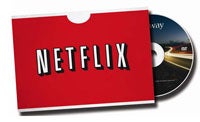In a year when DVD sales are falling and studios are facing major shakeups in their executive ranks, Hollywood is beginning to look a lot like one of its own slasher films, the Los Angeles Times noted recently. Amid all the turmoil, however, there is at least one success story in the movie industry: Netflix.
Founded in 1997, Los Gatos, Calif.-based Netflix made a splash in the movie rental business by offering an online subscription model with a flat monthly fee for unlimited rentals and no late charges. Since then, despite a recession, fierce competition and the emergence of online video delivery, the company continues to thrive. According to experts at Wharton, Netflix is now in a race to transition to a business model focused on streaming content online, while continuing to exploit its current model based on physical DVD distribution via the U.S. Postal Service. “You would think that Netflix would be entrenched in its old model and fighting off digital distribution, but it is embracing the future,” says Wharton marketing professor Peter Fader.
While many companies see the need to develop new business models as older, more profitable ones erode, not all of them deftly manage the transition. For years, Netflix has been mailing DVDs to subscribers in its recognizable red envelopes, but in 2008 it introduced a “Watch Instantly” service that allows consumers to stream movies on their home computers. Since then, the company has forged a bevy of partnerships to embed its Watch Instantly service in television sets, game consoles such as the Xbox, Blu-ray DVD players and set-top boxes. In its latest move, on October 26, the company announced a partnership with Sony to deliver its streaming service via Sony’s PlayStation 3 game console, nine million of which have sold since it was first introduced in 2006.
Netflix had 11.1 million subscribers through the third quarter ended September 30, up from 8.67 million for the same period a year earlier. The company predicts it will have 12 million to 12.3 million subscribers by the end of the year. For the nine months ended September 30, Netflix reported net income of $84.9 million on revenues of $1.22 billion, up from earnings of $60.3 million on revenues of $1 billion for the same period a year ago. According to Fader, Netflix’s low-priced subscription model — it offers plans that range between $4.99 and $16.99 a month — has helped to keep its churn rate low (4.4% for the third quarter).
On an earnings conference call October 22, Netflix co-founder and CEO Reed Hastings said the company’s goals were simple: Grow revenue, subscribers and earnings while expanding into streaming content. “Of the 115 million estimated households in America, 9.6% now subscribe to Netflix,” said Hastings. “In the greater San Francisco Bay Area, which we believe is a leading indicator of Internet behavior elsewhere in America, 21.2% of households now subscribe to Netflix, up 13% from one year ago.”
Hastings added that the company expects disc shipments through the mail and its 58 distribution centers “to grow for several more years as video stores close and our subscriber base expands.” For instance, Netflix rival Blockbuster, the largest movie rental chain in the U.S., plans to close 40% of its stores over the next two years as it focuses on launching kiosks and its own digital rental service. In a regulatory filing, Blockbuster said that 18% of its stores are unprofitable.
‘Netflix Killers’
However, Netflix faces intense competition from companies ranging from Apple with its iTunes service, which rents movies online, to Blockbuster and an upstart called Redbox, a division of Bellevue, Wash.-based Coinstar, which rents DVDs through kiosks primarily at supermarkets and convenience stores. The Redbox plan is simple: It charges $1 a day for a rental. Each kiosk holds between 70 and 200 titles, which are updated weekly. To keep up with growing demand, the company has nearly doubled its outlets during the past year to a total of 17,900 across the U.S. It expects to add another 8,500 this year. According to Video Business, revenues from video kiosks like Redbox will reach $1 billion by 2011.
Like its DVD rental business, Netflix’s video streaming model is under fire from powerful rivals. The most significant among these is YouTube, now part of Google’s mighty empire, which streams films for free off its Movies channel and competes directly with Netflix’s “Watch Instantly” service. To get a sense of the popularity of YouTube’s movie service, consider this: In late October, a documentary titled “Home” about climate change had been viewed more than 3.4 million times and more than 13,000 people had commented on it. Another challenger is Hulu, launched in March 2007 by News Corp. and NBC Universal, whom Disney joined as an investor this year. The company is an online video service that provides TV shows and movies from more than 190 content providers.
But it’s not as though competition is anything new for Netflix. So-called “Netflix killers” have surfaced repeatedly in the last decade. A significant threat loomed in 2002, when Walmart began an online rental service. However, the retail giant abandoned the project in 2005 after failing to gain traction with consumers. In addition, Walmart launched a movie download business and had to pull the plug on it in 2007 following a dispute over infrastructure with Hewlett-Packard. Now, the company has a cross-promotional deal with Netflix. In 2004, Blockbuster also started an online rental service, but it hasn’t been able to stop Netflix’s momentum. (Blockbuster does not offer separate sales figures for its online rental division.)
Wharton experts say that Netflix has proven its doubters wrong repeatedly, but it is unclear how the balancing act between the company’s old and new business models will play out. “Netflix has won round one with physical distribution of DVDs, but that advantage won’t [necessarily] persist” once the game switches to digital distribution, says Wharton management professor David Hsu.
For now, though, movie rental sales figures are playing to Netflix’s advantage, Hastings noted during his call. DVD rentals have held up well as consumers opt for cheaper forms of entertainment. According to research firm Digital Entertainment Group, third quarter consumer sales of DVDstotaled $4 billion, down 3.2 % from a year ago, but digital distribution (including on-demand video rentals and other forms of electronic delivery) was up 18% in the third quarter to $420 million. Meanwhile, media measurement firm Rentrak reported that movie rentals were up 9.9% for the quarter.
According to Wharton experts, particular strategies have helped Netflix maintain its lead. These include:
- Keeping one eye on the road and one eye on the turn ahead. “Any company that doesn’t keep its eye on where things are going and only focuses on the here-and-now risks having its market disappear,” says Kendall Whitehouse, director of new media at Wharton. “Netflix is positioned nicely for when the digital transition comes. It can exploit the current model [distributing physical discs] now and hedge against future technology changes with its Watch Instantly service.”
- Employing a subscription model. “One way to define Netflix is by the technologies it uses, but another way to define it is by its business model. Netflix took the per-item rental model and turned it into a subscription model. The ‘aha’ moment was really charging a subscription for a physical product,” says Dan Levinthal, a Wharton management professor.
- Moving quickly to stay ahead. “Some obvious lessons that can be learned from Netflix are: Target a niche and stay flexible,” says Wharton marketing professor Jehoshua (Josh) Eliashberg. “Netflix should be commended for moving fast to seize opportunities and technological trends.”
Community — the ‘Secret Sauce’
Another reason why Netflix has not stumbled is that it has established a relationship with its subscribers, say experts at Wharton. Because of its subscription model, the company has billing information for all of its customers, and that makes consumers less likely to jump ship. In addition, Netflix has fostered loyalty among subscribers with online community features such as its popular movie recommendation system.
“So much of what makes Netflix successful isn’t turning red envelopes around in the mail,” says Fader. “It’s the switching costs that Netflix builds in for customers. I have my rental queue, the company can recommend favorites with ratings and there’s a community. Customers have a lot invested with Netflix.”
Indeed, Netflix is highly focused on its community features. In September, the company awarded a $1 million prize to a team of engineers, statisticians and researchers that improved the accuracy of its movie recommendation system by 10%. At the same time,the company launched another $1 million competition with the aim of predicting movie enjoyment among members who don’t often rate what they watch.
“The Netflix challenge [to develop a better recommendation system] was all about making use of customer-specific information. It has nothing to do with DVDs at all. It’s about knowing what the customer wants,” Fader says. “Netflix could play well in other areas [with that information]. It has so many touch points to the customer.”
Andrea Matwyshyn, a Wharton legal studies and business ethics professor and a Netflix customer, says the company’s community of movie buffs is hard to match. She notes that Netflix carries a lot of independent movies and covers niche markets that Hollywood isn’t interested in. According to Matwyshyn, these niche markets have three primary benefits: little competition for content, loyal customers and some insulation from being completely reliant on big movie releases and content partnerships with Hollywood. “Netflix has the largest collection” — about 100,000 titles — “and a loyal following where customers are embedded with the company,” she says.
Leonard Lodish, a Wharton marketing professor, agrees. “Netflix has done a good job insulating its service from competitors, and a big part of that is that the company has good analytics and recommendations.”
In addition, Netflix is forging its customer relationships through distribution deals with consumer electronics manufacturers. These touch points will be critical as the industry evolves, says Wharton marketing professor Eric Bradlow. “There is a strong movement toward distribution everywhere [at] any time. People want to watch their movies on their [mobile devices]. People want to watch when traveling and in small time chunks. Netflix’s business model is really portable anywhere.”
The Transition to Digital Distribution
Experts at Wharton agree that Netflix’s continuing push into digital distribution and streaming video makes a lot of sense, but they warn that the transition in business models should be gradual. Netflix could be vulnerable if physical DVD rentals fall off too quickly — if, for example, consumers dropped all interest in DVDs in the next two years as opposed to a 10-year decline.
Fader predicts that Netflix’s business model is likely to benefit from physical DVD rentals for some time to come. “Netflix has much longer [to sustain] the old model than anyone says,” Fader notes. “People have been talking about the demise of Netflix for a long time now, but the fact that the company still thrives has already showed that markets aren’t nearly as turbulent as some think.” Netflix CEO Hastings said the company expects to be renting DVDs until 2030. As a result, the company is investing in more automated distribution plants that take returned DVDs, clean and inspect them and then reship to another customer.
Lodish says the longer Netflix can maintain its old model while investing in its digital streaming business, the better off it will be. Rivals can’t easily emulate the company’s distribution centers and information systems that allow it to deliver DVDs within one business day to 97% of its subscribers.”Building the infrastructure for sending out these DVDs was a big advantage for Netflix,” says Lodish. “Having warehouses all over is hard to duplicate.”
Levinthal agrees that Netflix will have a much harder time defending its position with a business model based on online delivery of video. The company’s physical assets have created a “moat” around the Netflix business model. “It’s ironic that old economy assets [such as distribution centers] gave a web company a sustained advantage for years,” he says. “Digital distribution lowers the barriers to compete with Netflix.”
Hastings countered some of those worries on the Netflix earnings conference call. Forty-two percent of Netflix subscribers streamed content at least 15 minutes in the third quarter, he noted. In addition, Netflix will begin to stream movies and TV shows internationally in the second half of 2010. And as these streaming activities increase–Netflix has a library of 17,000 movies and TV episodes for online viewing –the company will be able to lower its projected $600 million postage costs in 2010 and pass along more profits to content owners. “In the long term, as we license more content for streaming and as consumers use streaming more, that enormous and growing postal expense will start to flow to content owners, and we will become one of the studios’ and networks’ largest customers,” said Hastings.
Looming Competition
However, Hastings added that the more content Netflix licenses, the more it will invite new competitors. “Assuming that [streaming] video develops, [Netflix is] a threat to cable companies over time,” he said. Cable companies are experimenting with taking on-demand video to the Internet with a project called “TV Everywhere.” Hastings noted that Netflix could envision co-promotional deals with cable providers. “‘TV Everywhere’ is a threat to Netflix,” Levinthal says. “Cable companies become more scary to Netflix as they expand their on-demand offerings.”
Whitehouse adds that Redbox could nibble away at Netflix’s traditional DVD rental service with its low price and instant-gratification impulse purchase option for recent hit movies.
In addition, Apple’s iTunes and Amazon.com are also likely threats to Netflix in the future, say experts at Wharton. For now, Netflix has a clear edge over its rivals, which seem to be focused on individual parts of the entertainment puzzle, says Fader, who argues that Netflix’s biggest rival in the future may be Amazon, which is also going through a similar transition to digital content delivery. “A lot of Netflix’s competitors are so diffused. Each one is good at one piece of the puzzle, but no one takes [the company on directly].”
As Netflix moves toward a digital distribution model, its relationship with television and movie studios could change, notes Hsu. Under its physical DVD rental business, Wharton experts classify Netflix as more friend than foe to the studios. After all, the company is a valuable distribution channel for movies and is a valuable channel for digital content, too. Indeed, the company counts CBS, Disney and ABC, NBC Universal, New Line Cinema, MGM, 20th Century Fox and Lion’s Gate Entertainment as distribution partners. It also has a deal with cable channel Starz Entertainment to redistribute movies.
But if Netflix becomes one of the largest customers of the studios, as Hastings expects, the company’s clout could chafe Hollywood, says Hsu. Netflix will ultimately engage in “co-opetition,” where the company competes and cooperates at the same time, he notes. For instance, Netflix could dominate particular distribution channels and force content owners to create their own efforts to deliver content.
According to Hsu, the biggest worry for Netflix may ultimately be the movie studios themselves. He argues that movie studios could form a venture like Hulu and get into the distribution game. If distributors like Netflix and Apple garner too much clout, content providers are likely to move to take some of that power back. “The barrier to entry in streaming is much less and studios are likely to get into distribution,” says Hsu. It’s unclear what the landscape would look like if Netflix winds up competing with the movie studios that power its model — both digital and physical.
Bradlow says that Netflix is likely to be a friend to the studios no matter what model it uses. The more outlets there are for content, the better it is for the film industry. “I think among streaming providers, Netflix is a friend. This is an example where good competition will help grow the entire industry, which is still in its nascent stages.”



